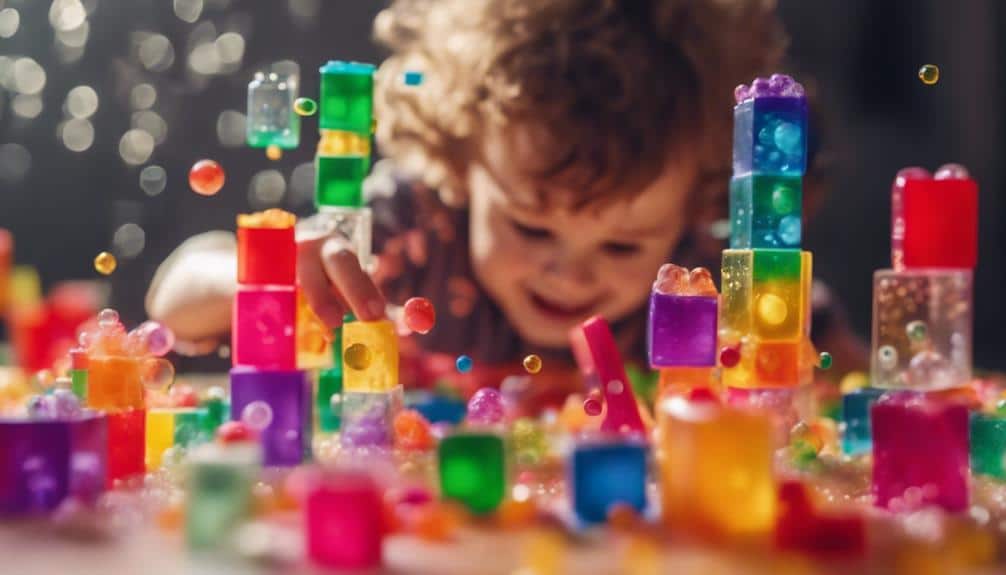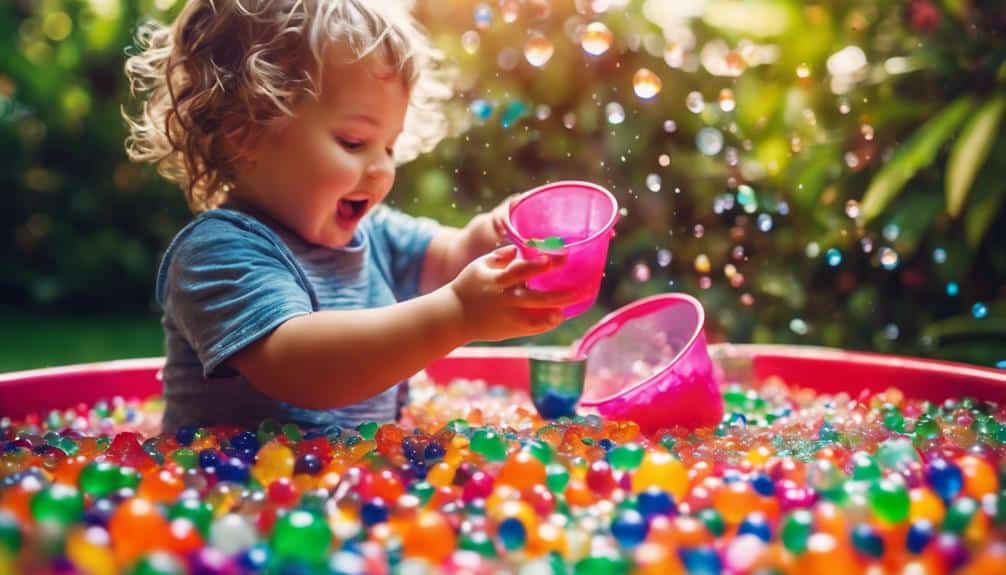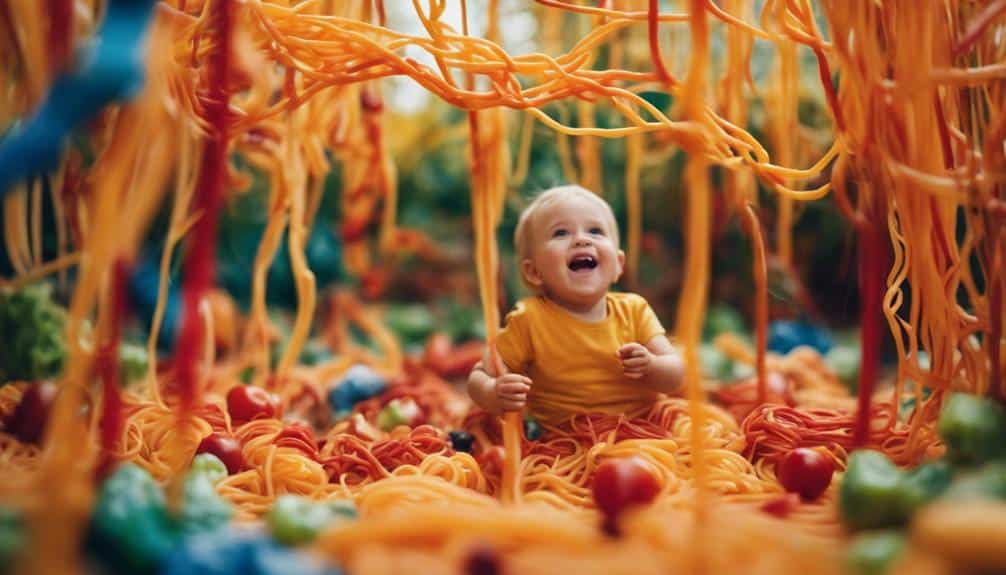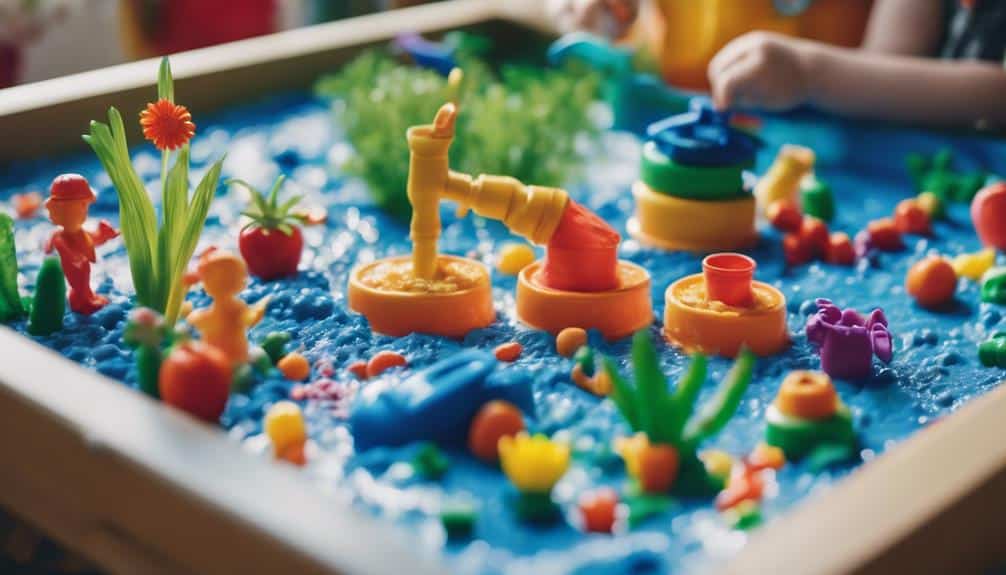Sensory play is a cornerstone in toddlers’ developmental journey, offering many benefits ranging from cognitive growth to fine motor skills enhancement. Compiling the top 7 sensory play ideas, including unique activities such as Velcro Board Harmony and Edible Spaghetti Forest, embodies an innovative approach to engage children’s senses safely. Each activity has been carefully selected to cater to the diverse needs of young learners, promising a fun experience and a significant contribution to their developmental milestones. To grasp these activities’ full potential, one must explore the intricate details and underlying benefits they offer to a child’s growth trajectory.
Key Takeaways
- Sensory play enhances toddlers’ fine motor skills, creativity, and cognitive development.
- Activities like water bead play and rainbow rice exploration stimulate multiple senses for well-rounded development.
- Creative options like an edible spaghetti forest provide safe exploratory play and foster imagination.
- Supervised activities ensure safety while allowing toddlers to learn through tactile and visual stimulation.
Velcro Board Harmony
Velcro boards engage toddlers in hands-on learning as interactive sensory tools that significantly enhance fine motor skills and promote tactile sensory exploration. These boards offer a dynamic platform for sensory play activities, allowing children to delve into a world where touch, sight, and coordination converge. As toddlers attach and detach various pieces, they refine their fine motor skills, an essential component of their developmental milestones. The repetitive action of manipulating the pieces fosters hand-eye coordination, paving the way for improved writing and self-care skills in the future.
Moreover, Velcro boards are a canvas for creativity, encouraging toddlers to experiment with colors, shapes, and patterns. This enhances their cognitive abilities and playfully introduces basic concepts of mathematics and geometry. By engaging in these sensory play activities, toddlers learn to identify and differentiate between various colors and shapes, enriching their vocabulary and comprehension.
The tactile sensory exploration facilitated by Velcro boards is invaluable. It supports cognitive development, encourages problem-solving, and boosts creativity, making it an essential tool in every caregiver’s arsenal. Through thoughtful engagement with these boards, caregivers can foster an environment of learning, exploration, and fun for toddlers.
Sponge Water Bombs
Turning our attention to sponge water bombs, we explore a hands-on activity that entertains and educates us. Creating these playful items is straightforward, fostering a sense of accomplishment and creativity in young minds. It is crucial, however, to observe certain safety precautions to ensure these sensory tools remain a beneficial aspect of a child’s development.
Making Process Simplified
Creating sponge water bombs is straightforward, requiring only basic materials like sponges and water to offer toddlers an enriching sensory and motor skills development experience. This activity fosters fine motor skills and hand-eye coordination and provides a safe sensory experience conducive to outdoor exploration.
To create sponge water bombs, follow these simple steps:
- Gather Materials: Collect soft sponges and scissors.
- Cut Sponges: Slice the sponges into long strips.
- Bundle and Secure: Secure the strips in the middle with a string or rubber band, creating a bomb shape.
- Soak in Water: Immerse in water until fully saturated.
Sponge water bombs are a fantastic addition to sensory play ideas, promoting activities for toddlers that are both educational and therapeutic.
Safety Precautions
While sponge water bombs offer a safer alternative to traditional water play items, adhering to specific safety precautions is essential to ensure a secure and enjoyable experience for toddlers.
| Safety Precaution | Reason | Implementation |
|---|---|---|
| Supervision | Prevent accidental ingestion | Always have an adult present |
| Choosing the Right Size | Avoid choking hazards | Use large enough pieces |
| Cleanliness | Maintain hygiene | Regularly clean and dry |
| Environmental Awareness | Prevent slips and falls | Play in a safe, non-slip area |
| Material Check | Ensure durability and safety | Use soft, non-toxic sponges |
Incorporating these safety measures can transform sponge water bombs into a fun sensory play activity, enriching sensory activities for toddlers with the joy of water play while using safe and engaging items.
Bubbly Block Towers

Bubbly Block Towers is an innovative sensory play activity designed to enhance toddlers’ fine motor skills and hand-eye coordination by creatively stacking foam blocks. This engaging activity fosters the development of essential physical abilities and nurtures creativity and imagination in young children. By arranging the blocks in various configurations, toddlers receive valuable tactile feedback and visual stimulation, contributing to a well-rounded sensory experience.
The benefits of introducing Bubbly Block Towers to toddlers include:
- Development of Fine Motor Skills: Manipulating the foam blocks helps toddlers refine their agility and control.
- Enhancement of Hand-Eye Coordination: As toddlers stack the blocks, they learn to coordinate their movements with what they see.
- Promotion of Creativity and Imagination: The open-ended nature of the activity encourages children to think creatively and imagine new structures.
- Calming Sensory Experience: The tactile feedback and focus required can be soothing to toddlers, making it an excellent activity for stimulation and relaxation.
Incorporating Bubbly Block Towers into sensory play routines offers a therapeutic and practical approach to supporting toddlers’ development. It serves their educational needs and provides a foundation for healthy sensory exploration.
Creative Ice Painting
Creative Ice Painting is an engaging sensory activity that introduces toddlers to the joys of color exploration using ice cubes as paintbrushes. This unique art form allows little ones to delve into their creative sides, making vibrant patterns and designs as the ice melts, blending colors in unexpected and delightful ways. As a sensory activity, ice painting is fun and immensely beneficial. It promotes the development of fine motor skills as toddlers grasp and maneuver the slippery ice, adapting their movements to control the placement of color. The tactile experiences provided by the cool touch of the ice stimulate sensory exploration, an essential aspect of toddler development that enhances their understanding of the world around them.
Furthermore, ice painting encourages creativity and imagination, vital components of cognitive growth. As toddlers experiment with different colors and watch them merge and change, they learn about cause and effect in a visually stimulating environment. This activity is particularly refreshing during warmer weather, offering a cool respite while keeping little ones engaged and learning through play. Ice painting is a multifaceted sensory activity that supports toddlers in growing their fine motor skills, creativity, and sensory awareness.
Water Bead Wonderland

Stepping into a Water Bead Wonderland offers toddlers an enchanting sensory experience, distinguished by the beads’ captivating colors and intriguing texture. Being non-toxic and biodegradable, water beads are safe and environmentally friendly options for sensory play. They expand when soaked in water, transforming into a world of colorful, smooth spheres that are irresistible to little hands. This sensory play activity is visually stimulating and encourages the development of fine motor skills and hand-eye coordination.
When introducing toddlers to water bead play, consider these practical tips for a safe and engaging experience:
- Always supervise toddlers during water bead play to ensure they don’t ingest the beads.
- Pre-soak the beads in water and allow them to reach full size before playtime.
- Incorporate tools such as scoops, tweezers, and funnels to enhance their sensory exploration and fine motor skill development.
- Mix water beads with other safe, non-toxic items to create themed sensory bins for a varied sensory experience.
Water bead play is educational and therapeutic and offers endless opportunities for creativity and exploration. It’s a beautiful way to support toddlers’ sensory development while providing a delightful and colorful sensory experience.
Rainbow Rice Exploration
Following the vibrant experience of Water Bead Wonderland, Rainbow Rice Exploration offers another enriching sensory journey for toddlers, engaging all five senses with its colorful and tactile play. This activity is a delightful visual spectacle and promotes essential developmental milestones such as fine motor skills and hand-eye coordination. Children can create their DIY rainbow using simple wooden tools, fostering a sense of achievement and creativity.
Rainbow Rice Exploration is celebrated for its therapeutic benefits, providing a calming yet stimulating environment for cognitive development. By participating in this sensory play, toddlers can explore, discover, and learn dynamically and enjoyably.
| Sensory Aspect | Benefit | Tools Used |
|---|---|---|
| Visual | Stimulates visual perception | Colorful rice |
| Tactile | Enhances touch sensitivity | Wooden tools |
| Auditory | Encourages sound recognition | Shaking rice |
| Cognitive | Promotes problem-solving | Sorting rice |
This activity is a testament to the power of sensory play in enriching the lives of toddlers, making Rainbow Rice Exploration a must-try for fostering early development and joy in learning.
Edible Spaghetti Forest

Diving into the world of sensory play, the Edible Spaghetti Forest offers toddlers an innovative way to engage their senses by manipulating colorful, cooked spaghetti shaped into a whimsical forest theme. This activity seamlessly combines the joy of play with the exploration of tactile sensory experiences, allowing children to dive into a world of imaginative play that is both safe and edible.
The benefits of integrating the Edible Spaghetti Forest into sensory play activities are vast:
- Promotes Tactile Sensory Exploration: Toddlers can feel the unique textures of cooked spaghetti, enhancing their tactile sensory development.
- Encourages Imaginative Play: The forest theme sparks creativity, allowing children to invent stories and scenarios as they play.
- Develops Fine Motor Skills: Manipulating the spaghetti aids in developing fine motor skills, which are crucial for writing and self-care tasks.
- Offers a Safe, Edible Option: This activity provides a safe, edible option for toddlers still exploring the world orally, minimizing risks.
The Edible Spaghetti Forest is a fun and engaging way for toddlers to explore different textures, colors, and shapes. Still, it also encourages sensory exploration and fine motor skills development in a playful, imaginative setting.
Frequently Asked Questions
What Are Some Examples of Sensory Play Ideas?
Examples of sensory play include activities that stimulate children’s senses, such as sensory bins filled with rice or beans, water play, finger or ice painting, playing with playdough, and exploring sounds with homemade musical instruments.
What Can I Put in My 2-Year-Old Sensory Bin?
For enhancing a 2-year-old’s sensory bin, consider incorporating colored rice, water beads, textured balls, and child-safe toys. These items foster sensory development, fine motor skills, and cognitive growth in a secure, supervised environment.
What Is Open-Ended Sensory Play for Toddlers?
Open-ended sensory play for toddlers is an exploratory activity without a predetermined outcome, allowing children to manipulate materials freely. This fosters creativity, problem-solving, and cognitive development, enhancing their sensory exploration and fine motor skills.
Is Sensory Play Good for 3-Year-Olds?
Sensory play serves as a bridge to a world of discovery for 3-year-olds, fostering cognitive, physical, and emotional growth. It’s instrumental in developing crucial skills, making it highly beneficial for their development.
Conclusion
Sensory play is a fun activity that promotes toddlers’ cognitive, sensory, and social development. With various textures, materials, and items, sensory play ideas provide endless opportunities for children to explore their senses. Here are some simple ideas for sensory play activities using everyday household items.
Create a sensory table by filling a plastic tub with kinetic sand, moon sand, or various textures and adding tools like cups, spoons, and cubes. Add a bit of color with food dye or liquid watercolors.
Create a sensory bottle by filling a water bottle with water, dish soap, or hair gel and adding rubber bands, cotton wool balls, or beads. You can also create sensory bottles with colored water or colored ice cubes.
Create a sensory dough by mixing a cup of flour with water and adding food coloring. You can also make Marshmallow Playdough or Peeps Playdough.
Create a sound treasure basket by filling a basket with fun items like jump ropes, stress balls, and bouncy balls. You can also create an Archeological Experience by hiding alphabet letters in a sensory tub.
These simple activities for toddlers provide stimulating play environments that promote sensory development, language development, and pre-writing skills. They also offer opportunities for children to engage in social interaction and improve their listening skills.
The Graham Child Development Institute recommends sensory play to promote young children’s brain and cognitive development. So why not try some of these sensory play ideas today? With a flat surface, a piece of paper, and some art materials, you can create a sensory play station that provides hours of fun and endless opportunities for children to explore their senses.


Recent Comments